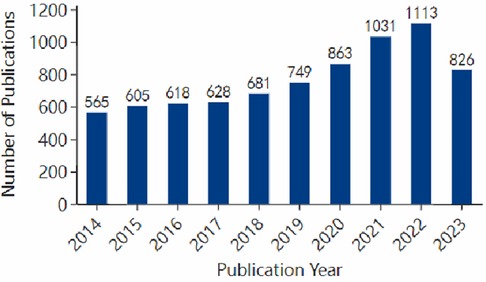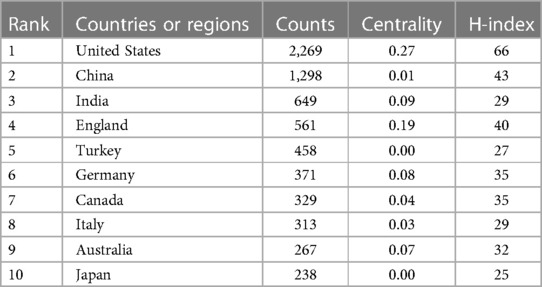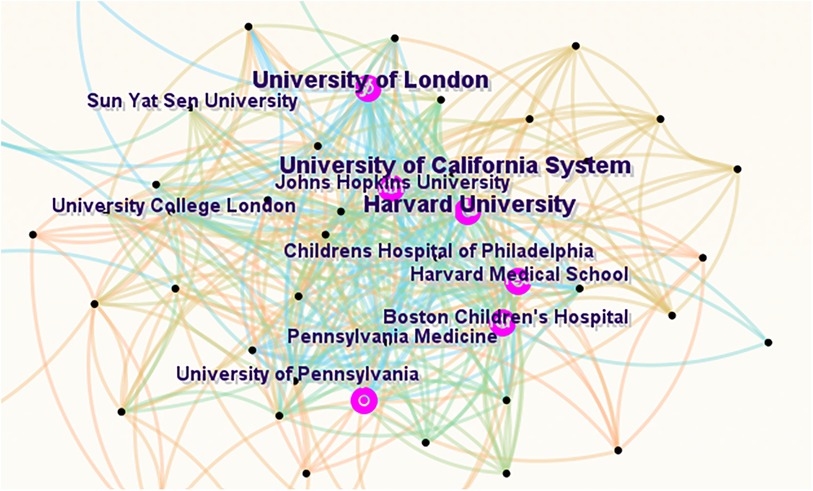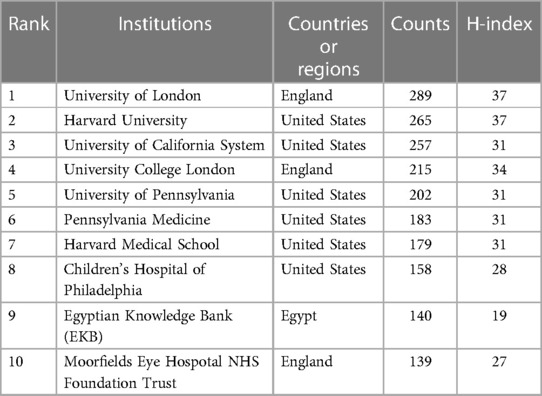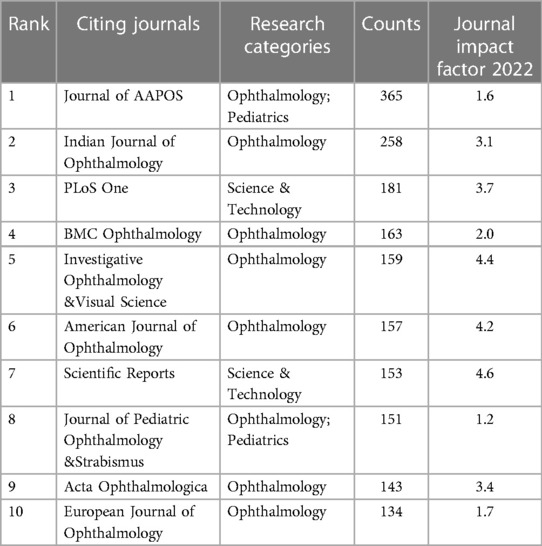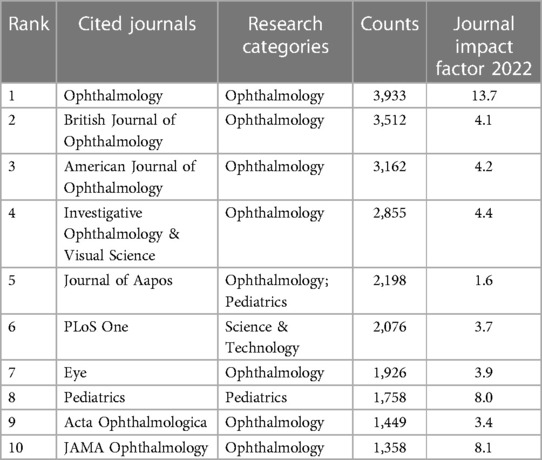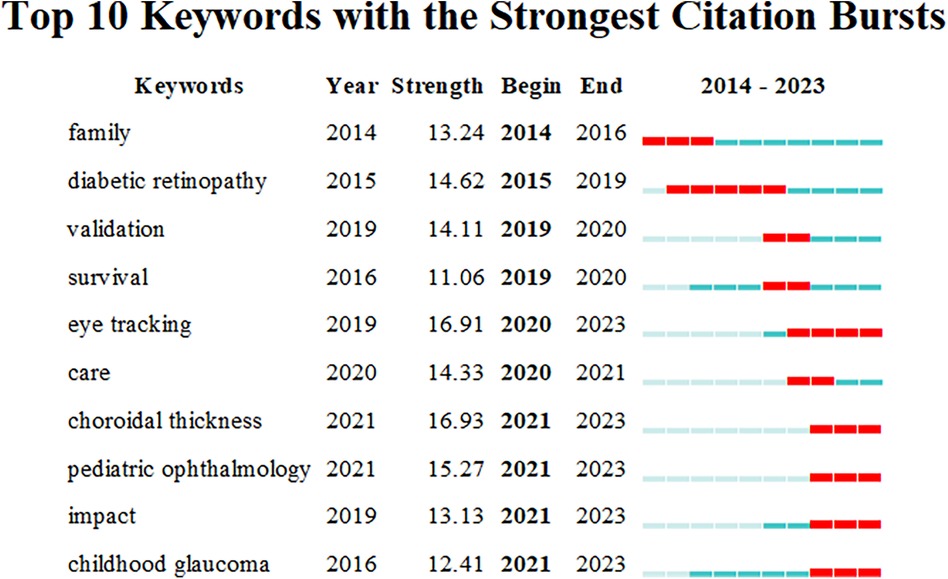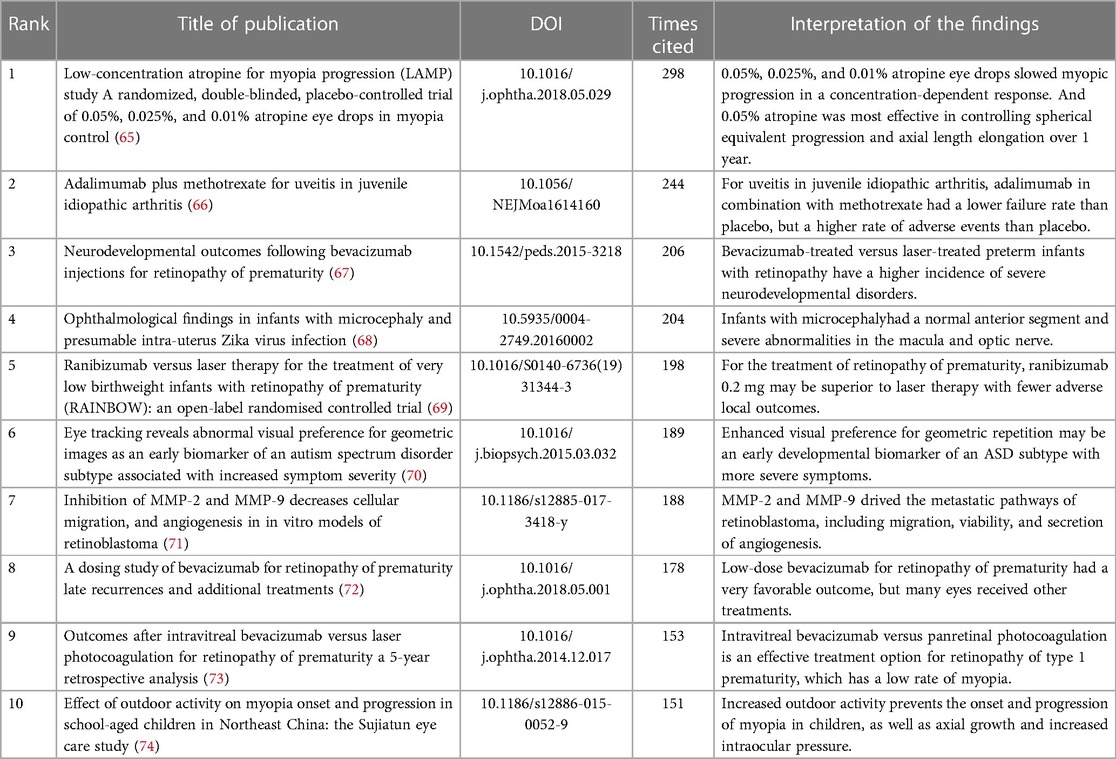- 1Department of Children Rehabilitation, First Affiliated Hospital of Xinxiang Medical University, Xinxiang, China
- 2Xinxiang Autism Integration Education Engineering Technology Research Center, Xinxiang, China
- 3Hebei University of Chinese Medicine, Shijiazhuang, China
- 4Shenzhen Eye Institute, Shenzhen Eye Hospital, Jinan University, Shenzhen, China
- 5The Third Affiliated Hospital of Xinxiang Medical University, Xinxiang Medical University, Xinxiang, China
Background: Ophthalmopathy occurring in childhood can easily lead to irreversible visual impairment, and therefore a great deal of clinical and fundamental researches have been conducted in pediatric ophthalmopathy. However, a few studies have been performed to analyze such large amounts of research using bibliometric methods. This study intended to apply bibliometric methods to analyze the research hotspots and trends in pediatric ophthalmopathy, providing a basis for clinical practice and scientific research to improve children's eye health.
Methods: Publications related to pediatric ophthalmopathy were searched and identified in the Web of Science Core Collection (WoSCC) database. Bibliometric and visualized analysis was performed using the WoSCC analysis system and CiteSpace.6.2.6 software, and high-impact publications were analyzed.
Results: This study included a total of 7,177 publications from 162 countries and regions. Of these, 2,269 from the United States and 1,298 from China. The centrality and H-index were highest in the United States at 0.27 and 66, respectively. The University of London and Harvard University had the highest H-index at 37. Freedman,Sharon F published 55 publications, with the highest H-index at 19. The emerging burst keyword in 2020–2023 was “eye tracking,” and the burst keywords in 2021–2023 were “choroidal thickness,” “pediatric ophthalmology,” “impact” and “childhood glaucoma.” Retinopathy of prematurity, myopia, retinoblastoma and uveitis in juvenile idiopathic arthritis were the main topics in the high-impact publications, with clinical studies in the majority, especially in retinopathy of prematurity.
Conclusion: Eye health in children is a research hotspot, with the United States publishing the largest number of papers and having the greatest influence in research on pediatric ophthalmopathy, and China coming in second. The University of London and Stanford University had the greatest influence. Freedman, Sharon F was the most influential author. Furthermore, “choroidal thickness,” “pediatric ophthalmology,” “impact,” “childhood glaucoma” and “eye tracking”are the latest hotspots in the field of pediatric ophthalmopathy. These hotspots represent hot diseases, hot technologies and holistic concepts, which are exactly the research trends in the field of pediatric ophthalmopathy, providing guidance and grounds for clinical practice and scientific research on children's eye health.
1 Introduction
Ophthalmopathy including include myopia, retinopathy, and glaucoma during childhood can significantly impact the development of visual, potentially leading to irreversible visual impairment, seriously affecting children's health and even contributing to long-term adverse social consequences. Specifically, myopia, in particular may affect children's quality of life and even posing a risk for blindness (1–3). Retinopathy of prematurity, a vasculopathy affecting the developing retinal vasculature in premature newborns, can result in retinal detachment, visual impairment, and blindness (4, 5). Glaucoma, which, if untreated timely, can cause sustained intraocular pressure increases, leading to optic nerve damage and vision loss (6, 7). Thus, timely diagnosis and treatment of ocular diseases in children are crucial, and modern technologies are required to apply in pediatric ophthalmopathy (8, 9). A holistic understanding of the current status and hotspots of research in this area can better provide reference for clinical workers and directions for researchers in pediatric ophthalmopathy.
Bibliometric analysis, first introduced in 1987, has been extensively applied across various fields to objectively assess research dynamics and frontiers, uncover available information in specific areas, and explore future research directions (10–12). While earlier studies have employed bibliometric methods to analyze pediatric ophthalmopathy, they have primarily focused on individual diseases, such as glaucoma (13), retinopathy of prematurity (14), and retinoblastoma (15), failing to offer a comprehensive overview and evaluation of pediatric ophthalmopathy. Consequently, this study conducted a bibliometric and visualized analysis of pediatric ophthalmopathy research to explore the research hotspots and trends in pediatric ophthalmopathy. Additionally, the Web of Science Core Collection (WoSCC) is the standard data set underpinning the journal impact metrics found in the Journal Citation Reports, providing high quality literature (16, 17); and the last decade literature reflects the latest research hotspots and trends that are more valuable to researchers as a research guide. Therefore, the data of this study was based on the literature of Woscc for the last decade to explore the research hotspots and trends in pediatric ophthalmopathy, potentially guiding future research in this field.
2 Materials and methods
The research methods included three parts: identifying the search strategy, selecting the publications and analyzing the data. In efforts to demonstrate research hotspots and trends in pediatric ophthalmopathy, high-quality, newly current mainstream publications from the WoSCC database need to be selected for data analysis. The search strategy included limiting the database, search terms, language, document type and publication date, and the specific search strategy was as follows: the database was selected from the WoSCC database, with topic = (“pediatric*” or “paediatric*” or “child*” or “infant*” or “adolescent*” or “neonate*” or “inborn”) and title = (“eye*” or “ophthalm*” or “retin*” or “cornea*” or “keratitis” or “uveal” or “uveitis” or “scleral” or “orbital” or “orbitopathy”or “glaucoma”), with a language restriction of English, an document type of article, and a publication date period from January 1, 2014 to December 31, 2023. The data was checked separately by two researchers. Further, secondary selection was performed based on document type and article content, Proccedings papers, review articles, book chapters, early eccess, editorial materials, letters, meeting abstracts, corrections, data papers and retracted publications were excluded on the basis of document type. The content of publications matching the doucument type was then screened based on the each title and abstract. If unsure, the full text was downloaded and excluded based on content. Publications that were not relevant to the topic of pediatric ophthalmopathy were excluded, such as pediatrics alone or eye disease alone. Bibliometric and visualized analysis was performed on the included publications, and Figure 1 shows the detailed flowchart. In the data analysis, CiteSpace.6.2.6 was used to analyze the collaborative network of countries or regions, institutions, journals, as well as keywords and research categories, and the analysis function of the WoSCC database was used to analyze the number of annual publications and the number of national or regional publications. At the same time, high-impact publications were analyzed in depth and detail to further demonstrate the popular research on children's eye diseases.
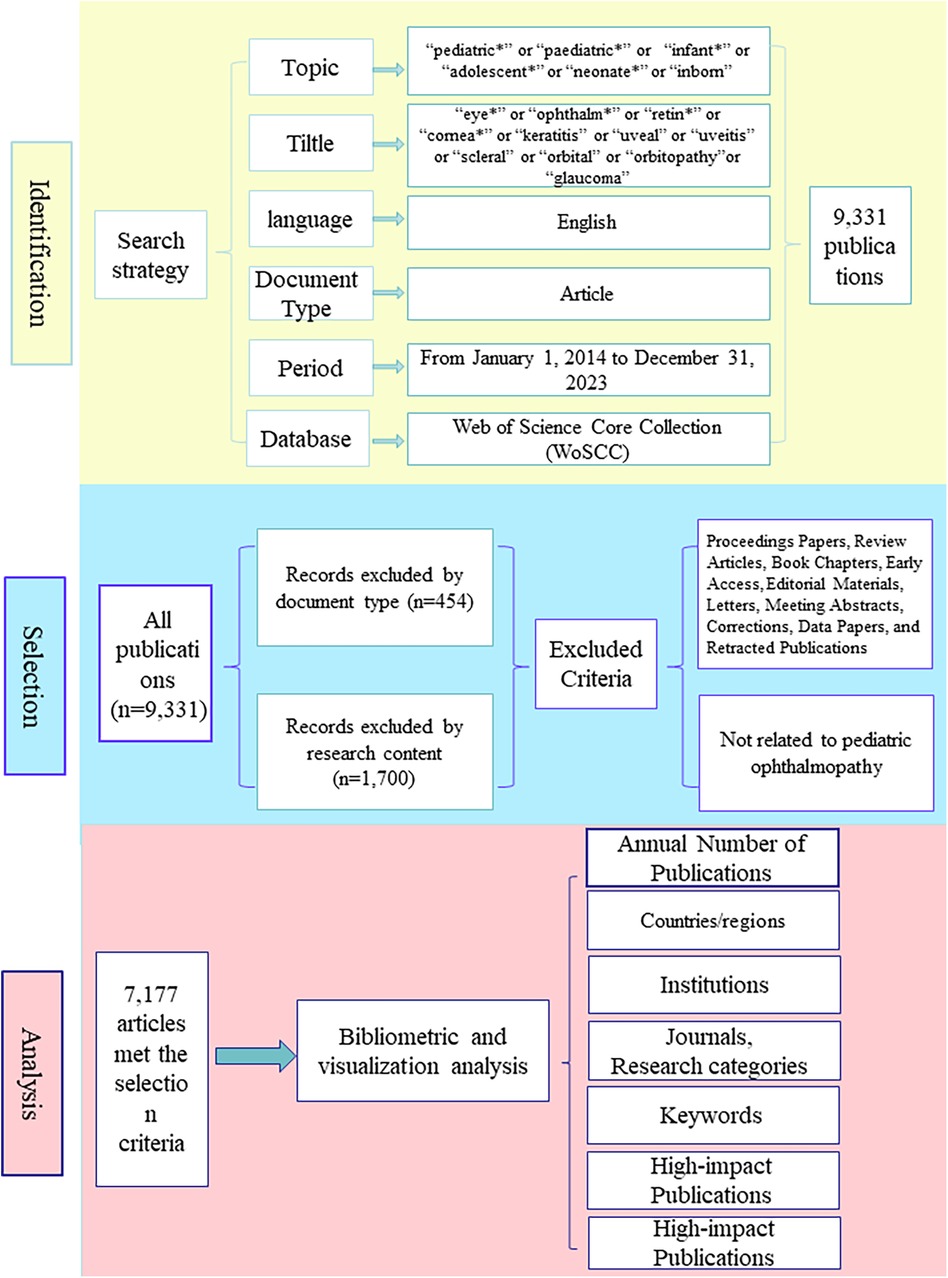
Figure 1. Frame flow diagram showing the detailed selection criteria and bibliometric analysis steps for the study of pediatric ophthalmopathy.
3 Results
3.1 Annual number of publications
Following the identification and selection process, this study encompassed 7,177 publications specifically addressing pediatric ophthalmopathy. Over the past decade, the annual publication count had consistently exceeded 500, with a notable surge in recent years, peaking at over 1,000 in 2021 and 2022. While the number of publications for 2023 was slightly lower than 2022 due to some articles not yet being publicly available online at the time of data collection. The trend in annual publication counts for pediatric ophthalmopathy over the last decade is illustrated in Figure 2.
3.2 Countries or regions
These publications originate from 162 countries and regions. Figure 3 presents a collaborative network graph for each country or region, with the default settings of CiteSpace. The size of each label and node region in Figure 3 is proportional to the number of publications. The United States (2,269), the People's Republic of China (1,298), and India (649) had the largest labels and node regions, indicating the highest publication volumes. Connections between nodes signify cooperative efforts between countries or regions, with more connections indicating closer collaboration. Table 1 provides details for the top 10 countries or regions based on publication numbers, including centrality scores that reflect the strength of their cooperation and H-indexes that measure influence. The United States lead with the highest centrality (0.27) and H-index (66); China followed with a lower centrality but maintains a significant presence; England, with 561 publications, had a high centrality of 0.19 and an H-index of 40.
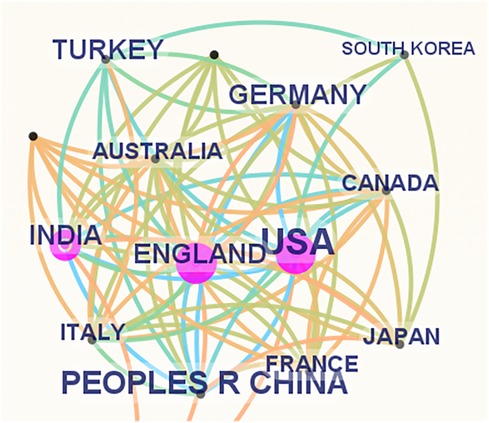
Figure 3. Cooperation of countries or regions that contributed to publications on pediatric ophthalmopathy.
3.3 Institutions
Figure 4 displays the collaborative network graph for institutions, with the default settings of CiteSpace. Each institution's label and node represent the number of publications, and the connections between nodes indicate cooperative relationships. Table 2 ranks the top 10 institutions by publication volume. The University of London, Harvard University, and the University of California System were the top three institutions in terms of publication output. The University of London and Harvard University shared the highest H-index of 37; all institutions in the top 7 had an H-index of 30 or higher. The top 10 institutions included six from the United States, three from England, and one from Egypt.
3.4 Journals and research categories
Publications exhibit a citing-cited relationship, as do the journals themselves, with citing journals reflecting current research frontiers and cited journals representing the research foundation. Tables 3, 4 list the top 10 citing and cited journals, including journal names, research categories, citation counts, and the 2022 Journal Impact Factor. CiteSpace was utilized to visualize and analyze these relationships under default settings. The most prominent citing-cited relationship in research categories was neurology/sports/ophthalmology citing molecular/biology/genetics. The prevalent research categories in the top 10 citing and cited journals were ophthalmology, pediatrics, and science and technology.
3.5 Authors
Figure 5 depicts the authors of publications and collaborations in the field of pediatric ophthalmopathy, with the node area indicating the volume of publications, the pink outer circle of the node denoting the influence, and the connecting lines representing the collaborative network. Table 5 exhibits information of the top 10 authors in terms of the number of publications, split into countries based on their institutions, with seven authors from the United States. The results reveal that Freedman,Sharon F was the most influential author with the highest number of publications in the field of pediatric ophthalmopathy.
3.6 Keywords
CiteSpace was employed to analyze co-occurring collaborative networks of keywords using the parameters: “Year Per Slice” = 1, “Top N%” = 10.0%, and “Minimum Duration” = 1. Figure 6 highlights the top 10 keywords with the strongest citation bursts, where strength indicates the intensity of the keyword's emergence. The red squares denote the timeline of keyword surges. “Diabetic retinopathy” and “eye tracking” were keywords with the longest periods of activity, while “eye tracking,” “choroidal thickness,” “pediatric ophthalmology,” “impact,” and “childhood glaucoma” were keywords that have emerged within the last three years.
3.7 High-impact publications
High-impact publications with high cited counts are indicative of well-regarded findings in pediatric ophthalmopathy, demonstrating the research hotspots in this field. Table 6 lists the top 10 most highly cited publications in this field, covering aspects of pathogenesis, diagnosis, and treatment of ocular diseases in children. These articles predominantly featured clinical studies, particularly those focused on the treatment of retinopathy of prematurity, alongside mechanistic studies such as one exploring the metastatic pathway of retinoblastoma. The types of diseases were related to retinopathy of prematurity (4), myopia (2), retinoblastoma (1), uveitis in juvenile idiopathic arthritis (1), and ocular manifestations of systemic diseases (2).
4 Discussion
4.1 Overall data
Pediatric ophthalmopathy directly impair children's vision, affecting not only their health and quality of life but also their families and society, making pediatric ophthalmopathy a focal point for research. This study analyzed publications in the past decade from the WoSCC database to obtain research hotspots and trends in the field of pediatric ophthalmopathy. The analysis indicates that over the past decade, there has been a significant increase in pediatric ophthalmopathy research, particularly after 2021, with an annual publication count exceeding 1,000. In terms of national or regional contributions, the United States lead with the highest number of publications, centrality, and H-index, reflecting its dominant role in the field. China, ranking second in publication volume and H-index but with lower centrality, also exert significant influence, suggesting a need for enhanced international collaboration. England, despite having fewer publications, demonstrated high centrality and influence, indicating the value and collaborative nature of its research. Institutions such as the University of London and Harvard University stand out with the highest H-index, indicating their substantial impact. Freedman,Sharon F was the most authoritative author, and most of the authors with high posting volume and influence were from the United States. The journal research categories revealed a focus on pediatrics, ophthalmology, and science and technology, aiming to develop more effective diagnostic and treatment methods for pediatric ophthalmopathy. The analysis of burst keywords highlights the current research hotspots, and highly cited articles showcase impactful research findings, with retinopathy of prematurity, myopia, and retinoblastoma emerging as prominent areas of study. Specifically, four articles on retinopathy of prematurity were clinical studies assessing the efficacy and adverse effects of various treatments, including laser therapy, bevacizumab, and ranibizumab. These treatments showed potential clinical efficacy, but bevacizumab, when compared to laser therapy, was associated with a higher incidence of severe neurodevelopmental disorders, while ranibizumab therapy was found to be superior, with fewer adverse outcomes.
4.2 Research hotspots
The analysis of the publications on pediatric ophthalmopathy in the WoSCC database over the past 10 years provides access to the research hotspots in this field. Emerging burst keywords responds to the research hotspots. The evolving burst keywords across different time periods reflect the shifting research focus in pediatric ophthalmopathy. In 2014–2016, the keyword “family” emerged, primarily encompassing family-related and genetically linked congenital eye diseases (18–20), as well as aspects of family care (21, 22). The keyword “diabetic retinopathy” gained prominence from 2015 to 2019, with a focus on early detection markers before clinical symptom onset, including retinal microcirculation changes (23), retinal nerve fiber layer thickness (24), choroidal thickness (25), and the integration of artificial intelligence methods (26). The keywords “validation” and “survival” emerged in 2019–2020, with “validation” referring to the clinical validation of guidelines, standards, and questionnaires related to pediatric ophthalmopathy (27, 28), and the capabilities of artificial intelligence platforms (29, 30). Additionally, “care” became a significant keyword in 2020–2021, highlighting the crucial role of care in pediatric ophthalmopathy (31, 32). The keywords “eye tracking” and “choroidal thickness” emerged in 2020–2023, followed by “pediatric ophthalmology,” “impact,” and “childhood glaucoma” in 2021–2023, indicating the latest research trends in the field.
“Eye tracking” technology, which can automatically monitor the visual dynamics of young children, has been applied in screening for autism spectrum disorder (33, 34), detecting glaucoma (35), quantifying the severity of intermittent esotropia (36), and assessing vision in infants and children (37). Ahmed et al. developed three AI techniques for early autism diagnosis using eye-tracking data, all achieving over 90% accuracy (38). Wen et al. proposed an automated acuity card procedure based on eye-tracking technology for assessing children's visual acuity, with results comparable to Teller Acuity Cards (37).
“Choroidal thickness” emerged as a keyword with significant intensity, serving as a critical indicator for assessing myopia development in children (39, 40). Zhu et al. found a positive correlation between the degree of myopia in children and choroidal thickness using Pearson correlation analysis (41). Jiang et al. discovered that choroidal thickness thinning in myopic patients was more pronounced nasally than temporally and superiorly, suggesting that asymmetric nasal predominance of thinning choroidal thickness could be a new biomarker for early-onset high myopia (42). Monitoring choroidal thickness may thus provide valuable insights, aligning with the high citation of articles focusing on myopia as the predominant disorder.
“Pediatric ophthalmology,” the dominant burst keyword from 2021 to 2023, signifies a growing interest in the field as a whole, with an increasing number of studies focusing on pediatric ophthalmology in general (43), rather than solely on children, pediatrics, or specific diseases. Ramsay et al. conducted a retrospective analysis of the epidemiology and diagnosis of pediatric ocular diseases in ophthalmology emergencies, summarizing patterns of pediatric ophthalmology consultations in such situations (44). As a subspecialty, this keyword also encompasses the development of pediatric ophthalmology, its economic and social impact (45–47), and the impact of economic factors, such as recessions, on the field and eye care (48).
The keyword “impact” addresses the effects of treatments and social factors on pediatric ophthalmopathy, as well as the repercussions of these conditions on family life and psychological well-being. Luccarelli et al. investigated the efficacy of oral acyclovir in preventing herpetic keratitis recurrences, demonstrating its safety and effectiveness (49). Shah et al. explored the impact of COVID-19 on pediatric ophthalmology emergency services, noting a decline in attendance (50). da Silva et al. assessed the psychosocial implications of surgical treatment for primary congenital glaucoma on children and their families (51).
“Childhood glaucoma,” a prevalent research topic, is characterized by a persistent increase in intraocular pressure, potentially leading to blindness. Surgical treatments for childhood glaucoma are a significant research area, encompassing procedures such as trabeculotomy (52), combined trabeculotomy-trabeculectomy (53), angio-atriotomy (54), Ahmed glaucoma drainage device implantation (55, 56), Baerveldt glaucoma drainage device implantation (57), ciliary body photocoagulation (58), and XEN gel stent implantation (59), as well as penetrating otoplasty for refractory cases (60). Visual outcomes have been correlated with factors such as age at diagnosis, corneal clouding, and the presence of concurrent amblyopia (61, 62). Recent research has also identified associations with genetic mutations (63, 64).
4.3 Trends discussion
The increasing number of publications in pediatric ophthalmopathy represents that this field is in a research hotspot. The emerging burst keywords and high-impact publications in recent years represent the changing trends in the field of pediatric ophthalmopathy. Myopia, childhood glaucoma, retinopathy of prematurity, retinoblastoma and uveitis in juvenile idiopathic arthritis are the hot diseases in research, and modern technology such as eye tracking has become a popular application technology for the diagnosis and intervention of pediatric ophthalmopathy, and the current research has focused more on the overall relationship between pediatric ophthalmopathy and social factors. These hot diseases, hot technologies, and holistic research are the research trends in the field of pediatric ophthalmopathy, which can inform clinical practice and will also become the directions of future research, and further improve eye health in children.
4.4 Limitations and resolvents
This study acknowledges several limitations that may affect the comprehensiveness and generalizability of the findings. Firstly, in order to high-quality articles, the publication selection was constrained by the use of the Web of Science Core Collection (WoSCC) database exclusively, which may have resulted in an incomplete collection of relevant literature. Utilizing multiple databases could have provided a more comprehensive view. Secondly, the search was restricted to English-language articles, potentially excluding valuable research from other linguistic domains. Thirdly, the document type was also limited to article, which may have omitted important contributions from other formats such as conference proceedings or reviews. And, some research results were not published in publications. And time constraints have been imposed to obtain hotspots for new timelines, which may lead to incomplete literature coverage. Additionally, the research content of the selected publications presents certain limitations. In clinical studies on medications, treatments, and pathogenesis of pediatric ophthalmopathy, the sample sizes are small, necessitating larger samples and cross-regional studies for more robust findings. The application of artificial intelligence in pediatric ophthalmopathy, while a growing area of scientific research, lacks sufficient clinical application studies and consistent models, which could hinder its practical implementation. The integration of resources to facilitate clinical research in this area is needed. Furthermore, the understanding of the underlying mechanisms of pediatric ophthalmopathy remains limited, indicating a need for more in-depth research in this domain.
5 Conclusion
This study offers a systematic bibliometric and visualized analysis of pediatric ophthalmopathy research over the past decade, providing a comprehensive overview of the field's current status and research hotspots. The study reveals a growing global interest in pediatric ophthalmopathy, particularly post-2021, with the United States and China exerting the most significant influence. Prominent institutions include the University of London and Stanford University, and Freedman,Sharon F was the most prominent. The primary research categories encompass pediatrics, ophthalmology, and science and technology, with a focus on diseases such as diabetic retinopathy, childhood glaucoma, retinopathy of prematurity, and myopia. Key areas of interest include “eye tracking,” “choroidal thickness,” “pediatric ophthalmology,” “impact,” and “childhood glaucoma.”
In summary, the study highlights ongoing in-depth research into the pathogenesis, screening, prevention, and treatment of pediatric ophthalmopathy. The integration of modern science and technology, such as eye tracking and deep learning, may offer more reliable methods for assessing and diagnosing these conditions. Further investigation into choroidal thickness could yield novel biological markers for myopia severity. Additionally, there is a growing emphasis on understanding the impact of childhood eye diseases on families and society. Given that ocular abnormalities in children can lead to irreversible vision damage and adverse effects on children eye health, early diagnosis and treatment are crucial for the prognosis of children's vision. Current research in pediatric ophthalmopathy primarily focuses on etiology, diagnosis, and treatment. However, there is a need for extensive research into the genetics and molecular mechanisms of pediatric ophthalmopathy to provide a more comprehensive and effective foundation for clinical practice.
Data availability statement
Publicly available datasets were analyzed in this study. This data can be found here: https://www.webofscience.com/.
Author contributions
QJ: Conceptualization, Data curation, Formal Analysis, Writing – original draft. XW: Data curation, Formal Analysis, Software, Visualization, Writing – original draft. XL: Formal Analysis, Software, Validation, Writing – original draft. CX: Methodology, Software, Visualization, Writing – original draft. QZ: Software, Visualization, Writing – original draft. JM: Funding acquisition, Methodology, Supervision, Visualization, Writing – review & editing. WY: Conceptualization, Methodology, Project administration, Resources, Writing – review & editing.
Funding
The author(s) declare financial support was received for the research, authorship, and/or publication of this article.
This study was supported by Shenzhen Fund for Guangdong Provincial High-level Clinical Key Specialties (SZGSP014), Sanming Project of Medicine in Shenzhen (SZSM202311012) and Shenzhen Science and Technology Program (JCYJ20230807114608016).
Conflict of interest
The authors declare that the research was conducted in the absence of any commercial or financial relationships that could be construed as a potential conflict of interest.
Publisher's note
All claims expressed in this article are solely those of the authors and do not necessarily represent those of their affiliated organizations, or those of the publisher, the editors and the reviewers. Any product that may be evaluated in this article, or claim that may be made by its manufacturer, is not guaranteed or endorsed by the publisher.
References
1. Bourke CM, Loughman J, Flitcroft D, Loskutova E, O’Brien C. We can’t afford to turn a blind eye to myopia. QJM- Int J Med. (2023) 116(8):635–9. doi: 10.1093/qjmed/hcz076
2. Yang YC, Hsu NW, Wang CY, Shyong MP, Tsai DC. Prevalence trend of myopia after promoting eye care in preschoolers A serial survey in Taiwan before and during the coronavirus disease 2019 pandemic. Ophthalmology. (2022) 129(2):181–90. doi: 10.1016/j.ophtha.2021.08.013
3. Wei SF, Li SM, Liu L, Li H, Kang MT, Sun YY, et al. Sleep duration, bedtime, and myopia progression in a 4-year follow-up of Chinese children: the Anyang childhood eye study. Invest Ophthalmol Vis Sci. (2020) 61(3):37. doi: 10.1167/iovs.61.3.37
4. Sen P, Wu WC, Chandra P, Vinekar A, Manchegowda PT, Bhende P. Retinopathy of prematurity treatment: Asian perspectives. Eye. (2020) 34(4):632–42. doi: 10.1038/s41433-019-0643-4
5. Dai C, Webster KA, Bhatt A, Tian H, Su G, Li W. Concurrent physiological and pathological angiogenesis in retinopathy of prematurity and emerging therapies. Int J Mol Sci. (2021) 22(9):4809. doi: 10.3390/ijms22094809
6. Tam EK, Elhusseiny AM, Shah AS, Mantagos IS, VanderVeen DK. Etiology and outcomes of childhood glaucoma at a tertiary referral center. J AAPOS. (2022) 26(3) 117.e1–e6. doi: 10.1016/j.jaapos.2021.12.009
7. Baig NB, Chan JJ, Ho JC, Tang GC, Tsang S, Wan KH, et al. Paediatric glaucoma in Hong Kong: a multicentre retrospective analysis of epidemiology, presentation, clinical interventions, and outcomes. Hong Kong Med J. (2021) 27(1):18–26. doi: 10.12809/hkmj208833
8. Yang WH, Shao Y, Xu YW, Expert Workgroup of Guidelines on Clinical Research Evaluation of Artificial Intelligence in Ophthalmology (2023), Ophthalmic Imaging and Intelligent Medicine Branch of Chinese Medicine Education Association, Intelligent Medicine Committee of Chinese Medicine Education Association. Guidelines on clinical research evaluation of artificial intelligence in ophthalmology (2023). Int J Ophthalmol. (2023) 16(9):1361–72. doi: 10.18240/ijo.2023.09.02
9. Zhu S, Zhan H, Yan Z, Wu M, Zheng B, Xu S, et al. Prediction of spherical equivalent refraction and axial length in children based on machine learning. Indian J Ophthalmol. (2023) 71(5):2115–31. doi: 10.4103/IJO.IJO_2989_22
10. Cuocolo R, Ponsiglione A, Dell’Aversana S, D’Acierno L, Lassandro G, Ugga L, et al. The cardiac conundrum: a systematic review and bibliometric analysis of authorship in cardiac magnetic resonance imaging studies. Insights Imaging. (2020) 11(1):42. doi: 10.1186/s13244-020-00850-1
11. Wang R, Zuo G, Li K, Li W, Xuan Z, Han Y, et al. Systematic bibliometric and visualized analysis of research hotspots and trends on the application of artificial intelligence in diabetic retinopathy. Front Endocrinol. (2022) 13:1036426. doi: 10.3389/fendo.2022.1036426
12. Feng H, Chen J, Zhang Z, Lou Y, Zhang S, Yang W. A bibliometric analysis of artificial intelligence applications in macular edema: exploring research hotspots and frontiers. Front Cell Dev Biol. (2023) 11:1174936. doi: 10.3389/fcell.2023.1174936
13. Jain D, Dhua AK. Bibliometric analysis of pediatric glaucoma. Indian J Ophthalmol. (2023) 71(5):2152–7. doi: 10.4103/IJO.IJO_2998_22
14. Zhang Z, Yang W, Lv H, Huang L, Yao T, He Y. The top 100 most cited manuscripts in retinopathy of prematurity: a bibliometric analysis. Semin Ophthalmol. (2023) 38(3):306–11. doi: 10.1080/08820538.2023.2177115
15. Gu X, Xie M, Jia R, Ge S. Publication trends of research on retinoblastoma during 2001–2021: a 20-year bibliometric analysis. Front Med. (2021) 8:675703. doi: 10.3389/fmed.2021.675703
16. Birkle C, Pendlebury DA, Schnell J, Adams J. Web of science as a data source for research on scientific and scholarly activity. Quant Sci Stud. (2020) 1(1):363–76. doi: 10.1162/qss_a_00018
17. Singh VK, Singh P, Karmakar M, Leta J, Mayr P. The journal coverage of web of science, scopus and dimensions: a comparative analysis. Scientometrics. (2021) 126:5113–42. doi: 10.1007/s11192-021-03948-5
18. Cardoso MS, Anjos R, Vieira L, Ferreira C, Xavier A, Brito C. CYP1B1 gene analysis and phenotypic correlation in Portuguese children with primary congenital glaucoma. Eur J Ophthalmol. (2015) 25(6):474–7. doi: 10.5301/ejo.5000618
19. Guo H, Li J, Gao F, Li J, Wu X, Liu Q. Whole-exome sequencing reveals a novel CHM gene mutation in a family with choroideremia initially diagnosed as retinitis pigmentosa. BMC Ophthalmol. (2015) 15:85. doi: 10.1186/s12886-015-0081-4
20. Branham K, Matsui H, Biswas P, Guru AA, Hicks M, Suk JJ, et al. Establishing the involvement of the novel gene AGBL5 in retinitis pigmentosa by whole genome sequencing. Physiol Genomics. (2016) 48(12):922–7. doi: 10.1152/physiolgenomics.00101.2016
21. Wang LJ, Zhong WX, Ji XD, Chen J. Depression, caregiver burden and social support among caregivers of retinoblastoma patients in China. Int J Nurs Pract. (2016) 22(5):478–85. doi: 10.1111/ijn.12458
22. Donaldson L, Subramanian A, Conway ML. Eye care in young children: a parent survey exploring access and barriers. Clin Exp Optom. (2018) 101(4):521–6. doi: 10.1111/cxo.12683
23. Inanc M, Tekin K, Kiziltoprak H, Ozalkak S, Doguizi S, Aycan Z. Changes in retinal microcirculation precede the clinical onset of diabetic retinopathy in children with type 1 diabetes Mellitus. Am J Ophthalmol. (2019) 207:37–44. doi: 10.1016/j.ajo.2019.04.011
24. Tekin K, Inanc M, Kurnaz E, Bayramoglu E, Aydemir E, Koc M, et al. Quantitative evaluation of early retinal changes in children with type 1 diabetes mellitus without retinopathy. Clin Exp Optom. (2018) 101(5):680–5. doi: 10.1111/cxo.12667
25. Golebiewska J, Olechowski A, Wysocka-Mincewicz M, Baszynska-Wilk M, Groszek A, Czeszyk-Piotrowicz A, et al. Choroidal thickness and ganglion cell Complex in pubescent children with type 1 diabetes without diabetic retinopathy analyzed by spectral domain optical coherence tomography. J Diabetes Res. (2018) 2018:5458015. doi: 10.1155/2018/5458015
26. Memari N, Ramli AR, Bin Saripan MI, Mashohor S, Moghbel M. Retinal blood vessel segmentation by using matched filtering and fuzzy C-means clustering with integrated level set method for diabetic retinopathy assessment. J Med Biol Eng. (2019) 39(5):713–31. doi: 10.1007/s40846-018-0454-2
27. Foeldvari I, Klotsche J, Simonini G, Edelsten C, Angeles-Han ST, Bangsgaard R, et al. Proposal for a definition for response to treatment, inactive disease and damage for JIA associated uveitis based on the validation of a uveitis related JIA outcome measures from the multinational interdisciplinary working group for uveitis in childhood (MIWGUC). Pediatr Rheumatol. (2019) 17(1):66. doi: 10.1186/s12969-019-0345-2
28. Caruggi S, Scaramuzzi M, Calevo MG, Priolo E, Sposetti L, Camicione P, et al. Validation of the postnatal growth and retinopathy of prematurity screening criteria: a retrospective Italian analysis. Eur J Ophthalmol. (2022) 32(2):1169–73. doi: 10.1177/11206721211011362
29. Lin H, Li R, Liu Z, Chen J, Yang Y, Chen H, et al. Diagnostic efficacy and therapeutic decision-making capacity of an artificial intelligence platform for childhood cataracts in eye clinics: a multicentre randomized controlled trial. EclinicalMedicine. (2019) 9:52–9. doi: 10.1016/j.eclinm.2019.03.001
30. Tong Y, Lu W, Deng QQ, Chen C, Shen Y. Automated identification of retinopathy of prematurity by image-based deep learning. EYE Vis. (2020) 7(1):40. doi: 10.1186/s40662-020-00206-2
31. Sachan A, Chandra P, Agarwal R, Vohra R, Chawla R, Sankar MJ, et al. Profile of retinopathy of prematurity in outborn and inborn babies at a tertiary eye care hospital. Indian Pediatr. (2020) 57(11):1020–2. doi: 10.1007/s13312-020-2027-z
32. Yousef YA, Al-Nawaiseh I, Mehyar M, Sultan I, Al-Hussaini M, Jaradat I, et al. How telemedicine and centralized care changed the natural history of retinoblastoma in a developing country analysis of 478 patients. Ophthalmology. (2021) 128(1):130–7. doi: 10.1016/j.ophtha.2020.07.026
33. Zhao Z, Tang H, Zhang X, Qu X, Hu X, Lu J. Classification of children with autism and typical development using eye-tracking data from face-to-face conversations: machine learning model development and performance evaluation. J Med Internet Res. (2021) 23(8):e29328. doi: 10.2196/29328
34. Wen TH, Cheng A, Andreason C, Zahiri J, Xiao Y, Xu R, et al. Large scale validation of an early-age eye-tracking biomarker of an autism spectrum disorder subtype. Sci Rep. (2022) 12(1):4253. doi: 10.1038/s41598-022-08102-6
35. Tatham AJ, Murray IC, McTrusty AD, Cameron LA, Perperidis A, Brash HM, et al. A case control study examining the feasibility of using eye tracking perimetry to differentiate patients with glaucoma from healthy controls. Sci Rep. (2021) 11(1):839. doi: 10.1038/s41598-020-80401-2
36. Economides JR, Dilbeck MD, Gentry TN, Horton JC. Ambulatory monitoring with eye tracking glasses to assess the severity of intermittent exotropia. Am J Ophthalmol. (2023) 250:120–9. doi: 10.1016/j.ajo.2023.01.014
37. Wen J, Yang B, Cui J, Wang L, Li X. An automated method for assessing visual acuity in infants and toddlers using an eye-tracking system. JOVE-J Vis Exp. (2023) (193):e65274. doi: 10.3791/65274
38. Ahmed IA, Senan EM, Rassem TH, Ali MAH, Shatnawi HSA, Alwazer SM, et al. Eye tracking-based diagnosis and early detection of autism Spectrum disorder using machine learning and deep learning techniques. Electronics (Basel). (2022) 11(4):530. doi: 10.3390/electronics11040530
39. Tian F, Zheng D, Zhang J, Liu L, Duan J, Guo Y, et al. Choroidal and retinal thickness and axial eye elongation in Chinese junior students. Invest Ophthalmol Vis Sci. (2021) 62(9):26. doi: 10.1167/iovs.62.9.26
40. Xu M, Yu X, Wan M, Feng K, Zhang J, Shen M, et al. Two-year longitudinal change in choroidal and retinal thickness in school-aged myopic children: exploratory analysis of clinical trials for myopia progression. EYE Vis. (2022) 9(1):5. doi: 10.1186/s40662-022-00276-4
41. Zhu H, Liu C, Gao M, Zhang S, Zhang L, Zhao Q. Choroidal thickness in relation to diopter and axial length among myopic children. Front Med. (2023) 10:1241352. doi: 10.3389/fmed.2023.1241352
42. Jiang Z, Hou A, Zhang T, Lai Y, Huang L, Ding X. Pattern of choroidal thickness in early-onset high myopia. Front Med. (2023) 10:1156259. doi: 10.3389/fmed.2023.1156259
43. Summers A, Kuo A, Zaback T, Loh AR, Brinks M, Hribar MR. Pediatric ophthalmology provider and staff attitudes and patient satisfaction in telehealth implementation during COVID-19. Telemed E-Health. (2022) 28(5):675–81. doi: 10.1089/tmj.2021.0189
44. Ramsay C, Murchison AP, Bilyk JR. Pediatric eye emergency department visits: retrospective review and evaluation. J Pediatr Ophthalmol Strabismus. (2021) 58(2):84–92. doi: 10.3928/01913913-20201118-01
45. Kalita IR, Veena K, Mouttappa F, Singh H. A study of referral pattern to pediatric ophthalmology department in a tertiary eye-care center of south-India. Indian J Ophthalmol. (2022) 70(1):223–7. doi: 10.4103/ijo.IJO_1446_21
46. Walsh HL, Parrish A, Hucko L, Sridhar J, Cavuoto KM. Access to pediatric ophthalmological care by geographic distribution and US population demographic characteristics in 2022. JAMA Ophthalmol. (2023) 141(3):242–9. doi: 10.1001/jamaophthalmol.2022.6010
47. Gautam N, Ram R, Bustamante E, Sharrah D, Mets-Halgrimson R. Pediatric ophthalmology inpatient consults at a tertiary care children’s hospital. J AAPOS. (2023) 27(2):004. doi: 10.1016/j.jaapos.2022.12.004
48. Lee KE, Sussberg JA, Nelson LB, Thuma T. The economic downturn of pediatric ophthalmology and its impact on access to eye care. J Pediatr Ophthalmol Strabismus. (2023) 60(1):18–24. doi: 10.3928/01913913-20221108-01
49. Luccarelli S, Lucentini S, Martellucci CA, Marelli L, Sacchi M, Nucci P. Impact of adherence (compliance) to oral Acyclovir prophylaxis in the recurrence of herpetic keratitis: long-term results from a pediatric cohort. Cornea. (2021) 40(9):1126–31. doi: 10.1097/ICO.0000000000002578
50. Shah K, Camhi SS, Sridhar J, Cavuoto KM. Impact of the coronavirus pandemic on pediatric eye-related emergency department services. J AAPOS. (2020) 24(6):367–9. doi: 10.1016/j.jaapos.2020.09.001
51. da Silva AO, Rolim-de-Moura C, Botelho NLP, Gracitelli CPB, Ferraz NN. Psychosocial indicators of primary congenital glaucoma and filtering surgeries impacts on children and family’s quality of life. Eur J Ophthalmol. (2022) 32(4):1997–2004. doi: 10.1177/11206721211048358
52. Sayed Y E, Esmael A, Mettias N, El Sanabary Z, Gawdat G. Factors influencing the outcome of goniotomy and trabeculotomy in primary congenital glaucoma. Br J Ophthalmol. (2021) 105(9):1250–5. doi: 10.1136/bjophthalmol-2018-313387
53. Mandal AK, Gothwal VK, Khanna R. Combined trabeculotomy-trabeculectomy for primary congenital glaucoma: long-term experience from a tertiary referral centre in a developing nation. Acta Ophthalmol (Copenh). (2022) 100(2):E439–47. doi: 10.1111/aos.14984
54. Kaushik S, Gupta G, Thattaruthody F, Dhingra D, Kumari K, Arora A, et al. Goniotomy for initial and re-surgery for childhood glaucoma in northern India. Indian J Ophthalmol. (2021) 69(8):2088–94. doi: 10.4103/ijo.IJO_3305_20
55. Promelle V, Lyons CJ. Long-term results of ahmed valve implantation with mitomycin-C in pediatric glaucoma. J Glaucoma. (2021) 30(7):596–605. doi: 10.1097/IJG.0000000000001881
56. Jacobson A, Rojas C, Bohnsack BL. Ologen augmentation of ahmed glaucoma drainage devices in pediatric glaucomas. BMC Ophthalmol. (2021) 21(1):72. doi: 10.1186/s12886-021-01827-4
57. Jacobson A, Besirli CG, Bohnsack BL. Outcomes of baerveldt glaucoma drainage devices in pediatric eyes. J Glaucoma. (2022) 31(6):468–77. doi: 10.1097/IJG.0000000000001970
58. Wagner FM, Schuster AK, Grehn F, Urbanek L, Pfeiffer N, Stingl JV, et al. Twenty-years of experience in childhood glaucoma surgery. J Clin Med. (2021) 10(24):5720. doi: 10.3390/jcm10245720
59. Ruparelia S, Berco E, Lichtinger A, Shoham-Hazon N. Multiple XEN gel stents for refractory pediatric glaucoma. J Pediatr Ophthalmol Strabismus. (2022) 59(1):E11–4. doi: 10.3928/01913913-20211101-03
60. Le R, Xie Y, Cheng H, Chen H, Ye W, Deng Y, et al. Outcomes of penetrating canaloplasty in childhood glaucoma. J Glaucoma. (2023) 32(1):34–9. doi: 10.1097/IJG.0000000000002111
61. Gusson E, Chemello F, Longo R, Franzolin E, Vesentini R, Verlato G, et al. Primary congenital glaucoma surgery: outcomes and visual function. Int Ophthalmol. (2021) 41(11):3861–7. doi: 10.1007/s10792-021-01957-0
62. Alshigari R, Freidi A, Souru C, Edward DP, Malik R. Risk factors for blindness in children with primary congenital glaucoma - follow-up of a registry cohort. Am J Ophthalmol. (2021) 224:238–45. doi: 10.1016/j.ajo.2020.12.014
63. Stingl JV, Diederich S, Diel H, Schuster AK, Wagner FM, Chronopoulos P, et al. First results from the prospective German registry for childhood glaucoma: phenotype-genotype association. J Clin Med. (2022) 11(1):16. doi: 10.3390/jcm11010016
64. Tehreem R, Arooj A, Siddiqui SN, Naz S, Afshan K, Firasat S. Mutation screening of the CYP1B1 gene reveals thirteen novel disease-causing variants in consanguineous Pakistani families causing primary congenital glaucoma. PLoS One. (2022) 17(9):e0274335. doi: 10.1371/journal.pone.0274335
65. Yam JC, Jiang Y, Tang SM, Law AKP, Chan JJ, Wong E, et al. Low-concentration atropine for myopia progression (LAMP) study A randomized, double-blinded, placebo-controlled trial of 0.05%, 0.025%, and 0.01% atropine eye drops in myopia control. Ophthalmology. (2019) 126(1):113–24. doi: 10.1016/j.ophtha.2018.05.029
66. Ramanan AV, Dick AD, Jones AP, McKay A, Williamson PR, Compeyrot-Lacassagne S, et al. Adalimumab plus methotrexate for uveitis in juvenile idiopathic arthritis. N Engl J Med. (2017) 376(17):1637–46. doi: 10.1056/NEJMoa1614160
67. Morin J, Luu TM, Superstein R, Ospina LH, Lefebvre F, Simard MN, et al. Neurodevelopmental outcomes following bevacizumab injections for retinopathy of prematurity. Pediatrics. (2016) 137(4):e20153218. doi: 10.1542/peds.2015-3218
68. Ventura CV, Maia M, Ventura BV, Linden VV, Araújo EB, Ramos RC, et al. Ophthalmological findings in infants with microcephaly and presumable intra-uterus Zika virus infection. Arq Bras Oftalmol. (2016) 79(1):1–3. doi: 10.5935/0004-2749.20160002
69. Stahl A, Lepore D, Fielder A, Fleck B, Reynolds JD, Chiang MF, et al. Ranibizumab versus laser therapy for the treatment of very low birthweight infants with retinopathy of prematurity (RAINBOW): an open-label randomised controlled trial. Lancet. (2019) 394(10208):1551–9. doi: 10.1016/S0140-6736(19)31344-3
70. Pierce K, Marinero S, Hazin R, McKenna B, Barnes CC, Malige A. Eye tracking reveals abnormal visual preference for geometric images as an early biomarker of an autism Spectrum disorder subtype associated with increased symptom severity. Biol Psychiatry. (2016) 79(8):657–66. doi: 10.1016/j.biopsych.2015.03.032
71. Webb AH, Gao BT, Goldsmith ZK, Irvine AS, Saleh N, Lee RP, et al. Inhibition of MMP-2 and MMP-9 decreases cellular migration, and angiogenesis in in vitro models of retinoblastoma. BMC Cancer. (2017) 17:434. doi: 10.1186/s12885-017-3418-y
72. Wallace DK, Dean TW, Hartnett ME, Kong L, Smith LE, Hubbard GB, et al. A dosing study of bevacizumab for retinopathy of prematurity late recurrences and additional treatments. Ophthalmology. (2018) 125(12):1961–6. doi: 10.1016/j.ophtha.2018.05.001
73. Hwang CK, Hubbard GB, Hutchinson AK, Lambert SR. Outcomes after intravitreal evacizumab versus Laser photocoagulation for retinopathy of prematurity A 5-year retrospective analysis. Ophthalmology. (2015) 122(5):1008–15. doi: 10.1016/j.ophtha.2014.12.017
Keywords: pediatric, ophthalmopathy, bibliometric, visualization, CiteSpace, hotspots, trends
Citation: Jia Q, Wang X, Li X, Xie C, Zhang Q, Mu J and Yang W (2024) Analysis of research hotspots and trends in pediatric ophthalmopathy based on 10 years of WoSCC literature. Front. Pediatr. 12:1405110. doi: 10.3389/fped.2024.1405110
Received: 22 March 2024; Accepted: 20 May 2024;
Published: 30 May 2024.
Edited by:
Shi Song Rong, Harvard Medical School, United StatesReviewed by:
José Aparecido Da Silva, University of Brasilia, BrazilThiago Gonçalves dos Santos Martins, Federal University of São Paulo, Brazil
© 2024 Jia, Wang, Li, Xie, Zhang, Mu and Yang. This is an open-access article distributed under the terms of the Creative Commons Attribution License (CC BY). The use, distribution or reproduction in other forums is permitted, provided the original author(s) and the copyright owner(s) are credited and that the original publication in this journal is cited, in accordance with accepted academic practice. No use, distribution or reproduction is permitted which does not comply with these terms.
*Correspondence: Weihua Yang, YmVuYmVuMDYwNkAxMzkuY29t; Jingfeng Mu, MTAxNDEyMDMwMEBxcS5jb20=; Cuijuan Xie, eGxqYTIzNzlAMTI2LmNvbQ==
†These authors have contributed equally to this work and share first authorship
 Qianfang Jia
Qianfang Jia Xiaofang Wang
Xiaofang Wang Xiwan Li1
Xiwan Li1 Cuijuan Xie
Cuijuan Xie Qing Zhang
Qing Zhang Jingfeng Mu
Jingfeng Mu Weihua Yang
Weihua Yang